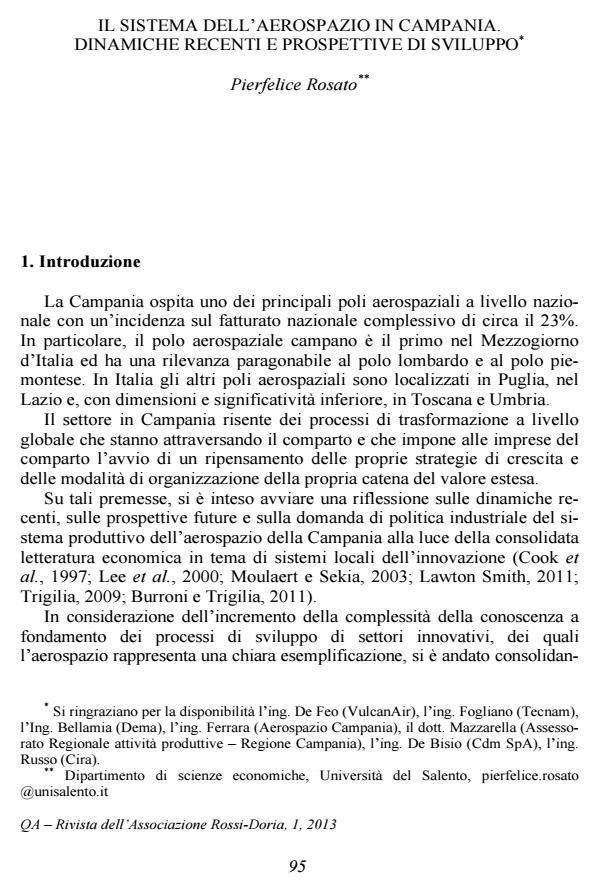The Aerospace Productive System in Campania. Recent Dynamics and Development Prospects
Journal title QA Rivista dell’Associazione Rossi-Doria
Author/s Pierfelice Rosato
Publishing Year 2013 Issue 2013/1 Language Italian
Pages 22 P. 95-116 File size 442 KB
DOI 10.3280/QU2013-001004
DOI is like a bar code for intellectual property: to have more infomation
click here
Below, you can see the article first page
If you want to buy this article in PDF format, you can do it, following the instructions to buy download credits

FrancoAngeli is member of Publishers International Linking Association, Inc (PILA), a not-for-profit association which run the CrossRef service enabling links to and from online scholarly content.
The aim of this paper is to describe the structure and the main competitive dynamics of the Aerospace productive system in Campania. After a preliminarily on-desk analysis, on-deep interviews were held with qualified regional stakeholders in order to analyze relations among enterprises and their main export markets. Great attention is given to their connection with local research centres, including the training of specialized human capital. Description of the public policies in support of the industry is followed by some brief observations on the productive system’s development prospects. EconLit Classification: M20, R500, L520, L600
Keywords: Aerospace, Apulia, Competitiveness, District, Industrial policy, Optimal level of government
- Agrawal A., Cockburn I.M. (2003), «The Anchor Tenant Hypothesis: Exploring the Role of Large, Local, R&D-Intensive Firms in Regional Innovation Systems », International Journal of Industrial Organization, 21, pp. 1227-1253.
- Almus M., Czarnitzky D. (2003), «The Effect of Public R&D Subsidies on Firms’ Innovation Activities: The Case of Eastern Germany», Journal of Business Economic Statistics, 21, pp. 226-326
- Bozeman B. (2000), «Technology Transfer and Public Policy: A Review of Research and Theory», Research Policy, 29, pp. 627-655
- Burroni L., Trigilia C. (2011), Le città dell’innovazione. Dove e perché cresce l’alta tecnologia in Italia, il Mulino, Bologna
- Camuffo A., Grandinetti R. (2006), «I distretti industriali come sistemi locali di innovazione», Sinergie, 69, pp. 33-60
- Coniglio N.D. (2013), «Politiche regionali per un’industria globale? Riflessioni sul sistema aerospazio in Puglia», QA – Rivista dell’Associazione Rossi-Doria, 1, pp. 73-93.
- Cooke P., Uranga M.G., Etxebarria G. (1997), «Regional Innovation Systems: Institutional and Organizational Dimensions», Research Policy, 26, pp. 475-491.
- Das T.K., Teng B.S. (1998), «Between Trust and Control: Developing Confidence in Partner Cooperation in Alliances», Academy of Management Review, 23, pp. 491-512
- Graham G., Ahmed P. (2000), «Buyer-Supplier Management in the Aerospace Value Chain», Integrated Manufacturing System, 11, 7, pp. 462-468
- Grandinetti R., Tabacco R. (2003), «I distretti industriali come laboratori cognitivi », Sviluppo locale, 22, pp. 49-83.
- Lawton Smith H. (2011), «Imprese ad alta tecnologia, università e sviluppo nella Regione di Oxford», Stato e Mercato, 93, pp. 451-478.
- Lee C.M., Miller W., Hancock M., Rowen H. (a cura di) (2000), The Silicon Valley Edge. A Habitat for Innovation and Entrepreneurship, Stanford University Press, Palo Alto, Ca.
- Leydesdorff L., Etzkowitz H. (1996), «Emergence of a Triple Helix of University– Industry–Government Relations», Science and Public Policy, 23, pp. 279-286.
- Lublinski A.E. (2003), «Does Geographical Proximity Matters? Evidence from Clustered and Non-Clustered Aeronautics Firms in Germany», Regional Studies, 37, 5, pp. 453-467.
- Markusen A. (1996) «Sticky Places in Slippery Space: A Typology of Industrial Districts», Economic Geography, 72, 3, pp. 293-313
- Methorios Capital (2011), Lo space manufacturing italiano ed europeo, settembre Documento disponibile online: http://www.methorios.it/web/presentazione/spacemanufacturing.pdf (ultimo accesso: 13 febbraio 2013).
- Moulaert F., Sekia F. (2003), «Territorial Innovation Models: A Critical Survey», Regional Studies, 37, 3, pp. 289-302
- Mustilli M., Campanella F., Sorrentino F. (2011), «La valutazione delle performance innovative dei sistemi locali d’innovazione: il caso dell’aerospazio e dei nuovi materiali in Campania», Sinergie, 84, pp. 209-229
- Niosi J., Zhegu M. (2005), «Aerospace Clusters: Local or Global Knowledge Spillovers?», Industry and Innovation, 12, 1, pp. 1-25
- Porter M.E. (1998), «Clusters and the New Economics of Competition», Harward Business Review, Nov-Dec, pp. 77-91
- Rebolledo C., Nollet J. (2011), «Learning from Suppliers in the Aerospace Industry », International Journal of Production Economics, 129, pp. 233-348
- Rullani E. (2006), «L’internazionalizzazione invisibile. La nuova geografia dei distretti e delle filiere produttive», Sinergie, 69, pp. 5-32.
- Trigilia C. (2009), Sociologia economica, Vol. II. Temi e percorsi contemporanei, il Mulino, Bologna
Pierfelice Rosato, Il sistema dell’aerospazio in Campania. Dinamiche recenti e prospettive di sviluppo in "QA Rivista dell’Associazione Rossi-Doria" 1/2013, pp 95-116, DOI: 10.3280/QU2013-001004